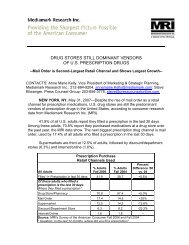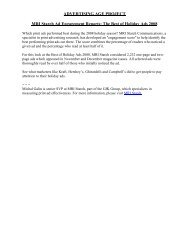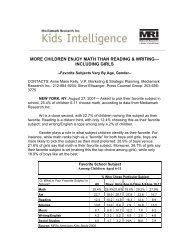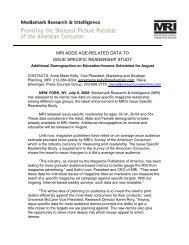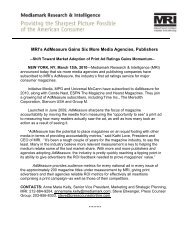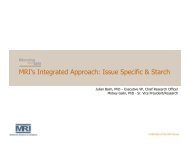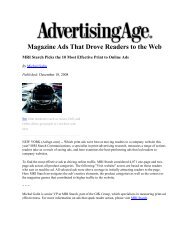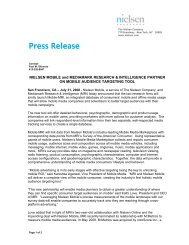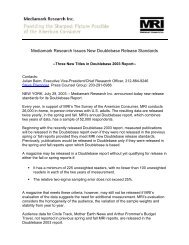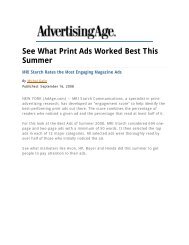A DAY IN THE LIFE: TRACKING E-READER AND ... - GfK MRI
A DAY IN THE LIFE: TRACKING E-READER AND ... - GfK MRI
A DAY IN THE LIFE: TRACKING E-READER AND ... - GfK MRI
Create successful ePaper yourself
Turn your PDF publications into a flip-book with our unique Google optimized e-Paper software.
A <strong>DAY</strong> <strong>IN</strong> <strong>THE</strong> <strong>LIFE</strong>: TRACK<strong>IN</strong>G E-<strong>READER</strong> <strong>AND</strong> TABLET OWNERS'<br />
ACTIVITIES <strong>AND</strong> PATTERNS OF USE<br />
Risa Becker, Jay Mattlin, Dr. Julian Bairn, Dr. Michal Galin, Matthew Pittsinger,<br />
Aaron Lipman, <strong>GfK</strong> <strong>MRI</strong><br />
Introduction<br />
As mobile devices such as the Apple iPad and a variety of e-readers grow in sales and usage, demand for information about<br />
how consumers interact with these devices increases. Tablets are unique in that almost all forms of traditional media can be<br />
consumed on these devices. Consumers use them to watch TV and movies, listen to the radio, access the Internet and read<br />
books, magazines and newspapers. E-readers, too, are increasingly becoming multi-media devices. Accordingly, publishers,<br />
agencies and all those intending to advertise to these consumers seek information about how consumers are engaging with e-<br />
reader and tablet devices.<br />
This paper provides a snapshot of owners' current behavior with e-readers and tablets, based on two surveys of a prerecruited<br />
panel — one on usage of these devices in general and one about their tablet or e-reader activities by daypart in a 1-<br />
day diary study. Through these surveys, we can begin to explore the degree to which the usage of these devices resembles or<br />
differs from the use of other media and, concomitantly, the degree to which usage of these devices may affect the usage of<br />
other media. In addition, this research reveals implications for future efforts to estimate audiences for what we think of as<br />
"traditional media" on these new delivery platforms.<br />
Background<br />
In recent years, and especially since the iPad's launch in April, 2010, publishers and agencies have attempted to understand<br />
consumers' adaptation to e-readers and tablets in principally in three ways:<br />
• Electronic tracking data from tags embedded within apps;<br />
• Surveys of e-reader and tablet owners, often administered on the device;<br />
• Qualitative research, either in groups or in one-on-ones.<br />
To date, there have been few explorations of tablet activities that take into account the full range of potential activities on a<br />
tablet, including the Internet, apps, and built-in functions by time of day and day of week (weekday vs. weekend). Even less<br />
is known about patterns of e-reader usage. As the provider of the U.S. print currency and of a single source media database,<br />
<strong>GfK</strong> <strong>MRI</strong> believes it critical to understand as much as possible about the full range of consumption behaviors and attitudes<br />
of tablet/e-reader owners. Thus, we recruited a panel of individuals comprised of e-reader and tablet owners, a portion of<br />
whom are respondents re-contacted from our National Study.<br />
This paper draws on surveys of these panelists to address the following questions:<br />
• For which activities are tablets and e-readers most commonly used -- including where magazine and newspaper<br />
reading fall among these uses -- and how do they differ by demographic group?<br />
• How do patterns of usage differ by weekday vs. weekend, daypart, and demographics, and how do these patterns<br />
compare to usage patterns for other media?<br />
• Do tablets and e-readers affect the consumption of other media and the execution of other activities and if so, how?<br />
• Are tablet and e-readers primarily employed as individual devices or are they shared among household members?<br />
This paper is an introduction to these topics and lays the groundwork for future, more in-depth analyses. While we<br />
recognize that there are many more issues of interest with regard to tablet and e-reader usage, we are limited by fieldwork<br />
timing and processing constraints to discussion of the issues above.<br />
Sample Design and Methodology<br />
The panel was developed from two separate sample sources: 1) recontacts of <strong>GfK</strong> <strong>MRI</strong>'s National Study respondents,<br />
supplemented by 2) a group of independently recruited panelists from a company called Hispanispace that specializes in<br />
recruiting and managing online communities for research,. (The name notwithstanding, Hispanispace does both Hispanicfocused<br />
and general population community recruitment.) The National Study respondents were individuals who had<br />
participated in a National Study personal interview some time between March 2009 and April, 2011. They were identified<br />
as likely owners of a tablet or e-reader in one of two ways: 1) they responded affirmatively to a question about e-reader or<br />
tablet ownership as part of the National Study personal interview or 2) they responded affirmatively to the ownership<br />
question in one of several mailed recontact studies. At the beginning of recruitment, GtK <strong>MRI</strong> identified 2,819 individuals<br />
who had reported in a previous study that they owned either an e-reader or a tablet. The panel was recruited by phone from<br />
1
June 7, 2011 to July 7, 2011. For those respondents for whom we had an email address and could not reach by phone, we<br />
sent a recruitment email.<br />
Respondents who agreed to join the panel were asked to provide their email address and were contacted by email the next<br />
day with a link to an online intake survey. They were told that they would be asked to participate in surveys online,<br />
approximately monthly, and that incentives would vary with the length of the survey.<br />
We also decided to supplement our panel with e-reader and tablet owners recruited by Hispanispace. This was done for two<br />
reasons. First, since the National Study respondents were somewhat skewed toward e-reader owners,' Hispanispace<br />
participation was intended to obtain a more balanced number of e-reader and tablet owners in the sample. Second, we<br />
wanted a higher intab overall.<br />
Hispanispace recruited their panelists from proprietary sources. Their recruits were invited to take part in surveys, as well as<br />
be part of a community of e-reader and tablet owners. Hispanispace panelists were incentivized less generously than the<br />
National Study respondents, but they benefited from being part of the community. Many of these panelists are enthusiastic<br />
and engaged, participating in qualitative surveys and discussions, in addition to the online quantitative surveys.<br />
Hispanispace guaranteed a minimum number of completions and replenishes the panel as necessary.<br />
The data in this paper come from two surveys administered to the panel, fielded between June 8, 2011 and August 30, 2011.<br />
The first survey, the "intake," included the following questions:<br />
• Brand of tablet or e-reader owned<br />
• Length of time owned<br />
• How respondents learned about apps<br />
• Number of apps owned, downloaded and amount spent<br />
• Types of apps used<br />
• How tablet or e-reader usage affects use of other media<br />
• Attitudinal questions concerning respondents' feelings about their tablet and/or e-reader.<br />
The second survey was a week-long diary study, designed to capture "a day in the life" of the panelist with respect to his or<br />
her tablet and/or e-reader usage. For this survey, respondents were asked each day, by daypart, to record their tablet and/or e-<br />
reader usage behavior. Variables collected were:<br />
• Tablet or e-reader activities done<br />
• Time spent on each activity<br />
• Location during activity<br />
• Whether the activity was "shared" (i.e. done together with another person) and<br />
• Whether respondent did any other activity (e.g. eating, watching television, etc.) concurrent with device<br />
usage.<br />
We attempted to re-contact, first by email and then by phone, all National Study respondents who did not respond to the<br />
initial post-recruitment, emailed invitation. In addition, to increase participation and to foster good will among respondents,<br />
<strong>GfK</strong> <strong>MRI</strong> sent the intake survey incentive, where possible, by overnight mail. Similarly, we also re-contacted, by both email<br />
and phone, potential diary participants who had not yet started the diary surveys.<br />
Panelists who had both an e-reader and a tablet (approximately 27% of the panel) were asked to fill in one diary for each<br />
device. Panelists who happened to have two e-readers or two tablets were instructed to choose the one device they used<br />
most often and complete the diary for that device. Start dates were staggered (Monday, Wednesday, Saturday starts) to<br />
minimize the effects of panel fatigue. Panelists were counted as in-tab if they filled out diaries for at least 5 of the 6 dayparts<br />
for at least 4 weekdays and 1 weekend day. We found that most panelists that qualified as completed diary interviews, did,<br />
in fact, complete all 6 dayparts for all 7 days.<br />
While there are currently too few National Study respondents to weight and project, the data may become projectable in the<br />
future with additional recruitment from future National Study samples. As the incidence level of tablet and e-reader<br />
ownership in the population grows and we continue to recruit new panelists, it is our intention to phase out Hispanispace<br />
panelists. It should therefore be noted that the results of these early panel studies should be viewed as suggestive/directional<br />
at this time.<br />
Sample Disposition and Demographics<br />
' The e-reader ownership question was introduced into <strong>GfK</strong> <strong>MRI</strong>'s National Study in March 2009, but the tablet ownership question was<br />
not introduced until September, 2010. Although the mailed recontact was intended to capture tablet ownership from respondents<br />
interviewed before the introduction of the tablet question, only a portion of National Study respondents (approximately 30%) complete the<br />
recontact surveys. This, along with the fact that tablet incidence in the population still lags behind that of e-readers (source: GM <strong>MRI</strong>'s<br />
Survey of the American Consumer, Spring, 2011), meant that we expected the National Study respondents to yield a greater number of<br />
panelists who owned e-readers than owned tablets.<br />
2
The field dispositions and the final intab counts for each of the two surveys are below:<br />
Sample Source<br />
Total Sample<br />
National Study<br />
Recontact<br />
Initial Recruitment Initial Sample 2,819<br />
Less: Total Ineligible 626<br />
Total Eligible 2,193<br />
Hispanispace<br />
Respondents<br />
Agreed to join Panel 497<br />
Intake survey<br />
Cooperation Rate 22.7%<br />
Intake survey Completes<br />
Total 421 2,702 3,123<br />
E-Reader 193 1,966 2,159<br />
Tablet 302 1,510 1,812<br />
Intake completion rate 84.7%<br />
7 Day Diary Diary survey Completes*<br />
Total 293 601 894<br />
E-Reader 210 347 557<br />
Tablet 133 429 562<br />
Diary completion rate (of 69.6% 22.2% 28.6%<br />
Intake completions)<br />
Note: Since data processing was incomplete at the time of this paper's writing, there is s ill a small percentage of respondents who are not<br />
included in these preliminary results. The intab numbers above include only those respondents processed and included in the analysis in this<br />
paper. Therefore these figures do not reflect the diary survey's final completion rate.<br />
The data presented below are based on 3,971 intake interviews with 3,123 respondents and 1,119 diary surveys with 894<br />
diary respondents. Both data sets include a portion of respondents who completed surveys for both devices.<br />
We also examined the distribution of demographics in the sample to determine whether these might have an effect on survey<br />
results. The following table shows the breakdown by sex and age of the diary respondents, compared to known, weighted<br />
distributions from our National Study.<br />
Demographics Tablet E-Reader<br />
7 Day Diary 7 Day Diary <strong>GfK</strong> <strong>MRI</strong> 7 Day Diary 7 Day Diary<br />
National Study<br />
Spring 2011<br />
<strong>GfK</strong> <strong>MRI</strong><br />
National Study<br />
Spring 2011<br />
Intab % of Tablet % of Tablet Intab % of E-reader % of E-reader<br />
Owners Owners<br />
Owners Owners<br />
Male<br />
237<br />
42.2<br />
53.7<br />
201<br />
36.2<br />
38.2<br />
Female<br />
325<br />
57.8<br />
46.3<br />
355<br />
63.8<br />
61.8<br />
Age 18-34<br />
263<br />
46.8<br />
32.2<br />
220<br />
39.6<br />
26.2<br />
Age 35-54<br />
210<br />
37.4<br />
50.0<br />
191<br />
34.4<br />
42.0<br />
Age 55+<br />
89<br />
15.8<br />
17.8<br />
145<br />
26.1<br />
31.9<br />
Note: One respondent was missing demographic information at the time of processing the diary study. For this reason, the sum of<br />
respondents by demographics is one less than the total by sample source.<br />
The table above shows that females are somewhat over-represented in the tablet diary study, while those aged 18-34 are<br />
over-represented and those aged 35-54 are under-represented in both the tablet and e-reader diary samples. Nonetheless, we<br />
concluded upon examination of age and gender differences that weighting by age and gender would have a minimal effect on<br />
the data shown. We therefore proceeded with our analysis without any weighting.<br />
3
Results and Observations<br />
Tablet and E-reader Activities<br />
The vast majority of these devices' owners do use them in an average week, as shown in the table below. Tablets are more<br />
likely to be used than e-readers, with almost a quarter of the e-reader respondents saying they hadn't used the device at all<br />
during the course of the week-long diary study. 2<br />
Table 1<br />
% of Respondents who Used Device, Last 7 days<br />
Tablet Owners E-Reader Owners<br />
86.1% 76.4%<br />
In general, there is little difference by sex and age with respect to overall weekly usage. Men were somewhat more likely<br />
than women to have used their tablet during the prior week. Gender does not seem to play a role, however, in overall usage<br />
of e-readers. And age appears to be negligibly related to the likelihood of usage of both devices in a given week.<br />
Chart 1<br />
% of Respondents who used their Tablet or E-reader, Last 7 days,<br />
by Age and Sex<br />
100<br />
80<br />
88.2<br />
84.5<br />
85.6 86 87.6<br />
■ Any Tablet<br />
Usage<br />
60<br />
Any E-Reader<br />
Usage<br />
40<br />
Men Women Age 18-34 Age 35-54<br />
Age 55+<br />
Perhaps not surprisingly, e-readers and tablets are used for very different purposes. Book-reading clearly dominates e-reader<br />
activity, with 63% of e-reader owners using their device to read books on an average day in the diary survey. The<br />
percentages of respondents conducting other activities on e-readers are all below 10%. Apart from book reading, the<br />
activities most likely mentioned by e-reader owners were:<br />
• sending email (8.1%),<br />
• reading magazines (7.6%),<br />
• reading newspapers (7.1%),<br />
• social networking (6.9%),<br />
• playing a single-player game (6.9%), and<br />
• visiting a website (5.6%).<br />
While many of the top activities for tablets mirror those for e-readers, tablet owners are much more likely to engage in these<br />
activities, indicating that tablets are generally used for a much wider variety of purposes. Top activities for tablet owners<br />
include:<br />
• sending email (52%),<br />
• social networking (37%),<br />
• visiting a website (32%),<br />
• obtaining information (31%),<br />
• playing a single-player game (25%), and<br />
• listening to music (16%).<br />
2 We cannot rule out the possibility that the percentages of non-users are inflated due to respondents' interests in shortening<br />
the interview.<br />
4
The top three tablet activities are Internet-related, indicating that the tablet is being used as a replacement for a desktop or<br />
laptop. These are the sorts of activities that might be thought of as daily habits on the Internet and so appear to have become<br />
daily habits for large numbers of tablet owners. Playing games and listening to music, activities more closely associated<br />
with mobile phones, were the two most common types of apps used by tablet owners in the prior 30 days, according to the<br />
intake survey.<br />
While tablet owners do use their device to read books, the percentage using their device for this activity on an average day is<br />
much lower than that for e-readers (14% vs. 63%). Newspaper and magazine reading, on the other hand, are about as<br />
common on tablets (9.1% for newspapers and 5.1% for magazines) as on e-readers (7.1% for newspapers and 7.6% for<br />
magazines). Watching TV or movies ranks below reading a book on tablets, but appears to be slightly more prevalent on<br />
tablets than consumption of either newspapers or magazines.<br />
Chart 2<br />
% of Tablet and E-Reader Owners Doing Specified Activity on an Average Day<br />
Bases: All Tablet Owners and All E-Reader Owners<br />
Looked at a magazine-related app<br />
Uploaded or Downloaded music<br />
Looked at a newspaper-related app<br />
Took a picture or video<br />
Read a magazine<br />
Purchased a product or service<br />
NMI<br />
Used a map/navigation system<br />
Uploaded or looked at photos<br />
Played a multi-player game<br />
Watched other video<br />
Read a newspaper<br />
Something else<br />
E-reader<br />
■ Tablet<br />
Watched a movie or TV show<br />
Read a book<br />
Listened to music<br />
Played a single-player game<br />
loomm<br />
A1111,11•11M<strong>IN</strong>NIORNMOMIEN<strong>IN</strong>UOMIEW<br />
)1116+-<br />
Obtained information<br />
Visited a search engine or an other...<br />
Social networking<br />
Read or sent an e-mail<br />
0 10 20 30 40 50 60 70<br />
Activities on the respective devices differ by demographics. (See Tables Al and A2 in the Appendix.) Men were more<br />
likely than women, on both e-readers and tablets, to listen to music, to read magazines and newspapers, and to use<br />
newspaper-related apps. Women were more likely than men to have read a book on a tablet. E-reader owners aged 18-34<br />
were more likely than their elders to treat their e-reader as a multimedia device and use it for a variety of activities, such as<br />
listening to music and social networking. E-reader owners 55+ were the least likely to use e-readers for anything besides<br />
reading books and playing games. Tablet owners who were 18-34 were the most likely to have listened to music and to have<br />
watched a movie, TV show or other video on their devices. Tablet owners aged 35-54 were most likely to have read a<br />
newspaper or to have purchased a product or service on their tablet devices. Tablet owners aged 55+ were the most likely to<br />
report playing single-player games in their diary surveys. Perhaps the games they are playing are more the sort of simple,<br />
5
daily habitual diversions (e.g., Solitaire, Sudoku) that younger device owners are more accustomed to playing on their<br />
mobile devices. This pattern bears re-examination over time.<br />
Patterns of Usage<br />
In contrast to the weekday dominance reported in Google's tablet survey ("Tablets Are Changing the Way Consumers<br />
Engage with Content," posted by Harsh Shah, April 17, 2011, http://aooglemobileads.blogsnot.com/2011/04/tablets-arechanging-way-consumers.html),<br />
the percentage of tablet owners using their device dips only slightly on weekends, while e-<br />
reader usage changes little, if at all.<br />
Table 2<br />
% of Tablet and E-reader Owners using the Device on an Average Weekday or Average Weekend Day<br />
Used Device Weekday Weekend<br />
Tablet 87.0% 83.7%<br />
E-reader 76.8% 75.6%<br />
However, consistent with Google's findings, our diary survey showed that for almost all activities, tablet owners and e-<br />
reader owners are more likely to report doing a particular activity on a weekday than a weekend day. Emailing on tablets<br />
was particularly more apt to be done on weekdays than on weekends. The only activities with noticeably higher incidence<br />
levels on weekends were using a map/navigation system and taking a picture or video. E-reader owners, like tablet owners,<br />
tend to do all activities somewhat more on weekdays than weekends. Overall, however, use of these devices does not appear<br />
to be relegated to either weekdays or weekends; people tend to use them throughout the week.<br />
Chart 3<br />
% of Tablet Owners Doing Specified Activity on an Average Weekday and Weekend Day<br />
Base: All Tablet Owners<br />
Read or sent an e-mail<br />
Social networking<br />
Visited a search engine or another website<br />
Obtained information<br />
Played a single-player game<br />
■<br />
Listened to music<br />
Read a book<br />
Watched a movie or TV show<br />
Something else<br />
Read a newspaper<br />
Watched other video<br />
Uploaded or looked at photos<br />
Played a multi-player game<br />
Purchased a product or service<br />
Used a map/navigation system<br />
Read a magazine<br />
Looked at a newspaper-related app<br />
Took a picture or video<br />
Uploaded or Downloaded music<br />
Looked at a magazine-related app<br />
limmuni)<br />
Weekend<br />
■ Weekday<br />
0% 10% 20% 30% 40% 50% 60%<br />
6
Chart 4<br />
% of E-reader Owners Doing Specified Activity on an Average Weekday and Weekend Day<br />
Base: An E-reader Owners<br />
Purchased a product or service<br />
Listened to music<br />
Visited a search engine or another website<br />
Played a single-player game<br />
Obtained information<br />
Read a newspaper<br />
Read a magazine<br />
Read or sent an e-mail<br />
Social networking<br />
Read a book<br />
0% 10% 20% 30% 40% 50% 60% 70%<br />
During each time period throughout the day (except late at night and in the early morning), more than 20% of e-reader<br />
owners and more than 30% of tablet owners use their devices at some point within the period. Consistent with their overall<br />
more frequent usage, tablets appear to be used more often than e-readers at all times before 11 PM and exhibit a bit more<br />
consistency in usage throughout the day. While tablet usage dips slightly between 9AM and noon, tablets otherwise seem to<br />
be used at a relatively constant rate during afternoon work hours, dinner hours, and during TV's primetime. 3 There is no<br />
distinct peak time for the use of tablets. E-readers, on the other hand, do peak during the prime-time evening hours and dip<br />
during the dinner hours.<br />
Chart 5<br />
% of Respondents, on Average, Using Device by Daypart<br />
Base: All Tablet and E-Reader Owners<br />
45<br />
40<br />
35<br />
34.9<br />
30<br />
25<br />
20<br />
15<br />
10<br />
5<br />
21.6<br />
12.8<br />
12.4<br />
•■•—E-reader<br />
Tablet<br />
0<br />
6-9 am 9-12 noon Noon-5pm 5pm-8pm 8 pm-11pm 11-pm-6am<br />
3 It should be noted that two of the six dayparts in these charts are longer than the other four. Therefore, the percentage using<br />
a device or medium in the five hours between noon and 5 PM would be expected to be higher than in the three-hour<br />
dayparts, if the hourly rates of usage were all the same.<br />
7
These usage patterns do not really resemble those for any major medium. In Chart 6, the daypart data for tablets and e-<br />
readers are plotted alongside data for the five major media which were collected in <strong>GfK</strong> <strong>MRI</strong>'s annual, syndicated<br />
MediaDay Study. MediaDay is a recontact telephone survey of respondents to our National Study that asks respondents<br />
about their consumption of each medium in blocks of time over the previous day. The methodology is different from that of<br />
the panel diary study reported here in mode (telephone vs. online), number of days covered (seven vs. one), and the way that<br />
duration of activity is assessed (to be discussed below), but the questioning procedures are sufficiently similar to allow for a<br />
broad comparison. In this chart, the bases for tablet and e-reader consumption are those who used tablets and e-readers,<br />
respectively, at any time during the diary study. The bases for all other media are those who used that medium at some time<br />
during the prior day. Setting the bases of the percentages to the user populations for each medium serves to make usage data<br />
more comparable across media, because the diary study was done only among owners of tablets and e-readers.<br />
This chart indicates that:<br />
• Tablet usage follows a distinct profile. Use of tablets is flatter through the course of an average day than usage of<br />
any major medium. Unlike radio and television, there is no clear-cut peak usage time for tablets.<br />
• Moreover, other than television, tablets are the only platform/medium to experience an increase in usage between<br />
afternoon and early evening.<br />
• The major medium whose usage trajectory is closest to the tablet is the Internet. Given the most popular uses of<br />
the tablet, this similarity is not surprising.<br />
• E-readers' usage profile through the day is probably closer to that of television than of any other medium, in that,<br />
like television, usage rates tend to increase through the day. Newspaper consumption generally declines through<br />
the day, and magazine consumption climbs through mid-day and then falls. However, e-reader usage does not<br />
climb as rapidly as usage of television at any time of day.<br />
• E-reader usage ranks second to television in the increase in the proportion of users between early evening and<br />
prime time. The Internet is the only other medium that experiences a prime time rise. Use of all other major<br />
media/platforms falls at that time.<br />
90%<br />
Chart 6<br />
Average % Using Each Medium/Platform by Daypart<br />
Bases: User of Each Individual Medium<br />
80%<br />
70% —<br />
60%<br />
50%<br />
40%<br />
30%<br />
20%<br />
■•••■■ Radio<br />
Newspaper<br />
blet<br />
.—X—Internet<br />
TV<br />
E-reader<br />
Magazine<br />
10%<br />
0% —<br />
6 -9 am 9-12 noon Noon-5pm 5pm-8pm 8 pm-11pm<br />
The smooth pattern of tablet usage across all dayparts for an average day obscures a key difference in usage of tablets<br />
between weekdays and weekends: Between 5:00 and 8:00 PM, usage actually increases on weekdays and declines on<br />
weekends. Tablet usage peaks during this dinner time period on weekdays, but peaks in the afternoon on weekends. This<br />
difference is probably due to increased socializing during the 5:00 to 8:00 time period on the weekends. For e-readers, there<br />
8
is a 5-8pm dip in usage on both weekdays and weekends, but it seems more pronounced on weekends. Otherwise, there is<br />
little difference between weekdays and weekends in patterns of e-reader usage through the day.<br />
Chart 7<br />
% of Tablet Owners, on Average, Using the Device by Daypart,<br />
Weekday vs. Weekend<br />
50%<br />
45%<br />
40%<br />
35%<br />
30%<br />
25%<br />
20%<br />
15%<br />
10%<br />
5%<br />
0%<br />
6-9 am 9-12 noon Noon-5 pm 5pm-8pm 8 pm-11pm 11-pm-6am<br />
12.4%<br />
—0--Weekday<br />
Weekend<br />
Chart 8<br />
% of E-Reader Owners, on Average, Using the Device by Daypart,<br />
Weekday vs. Weekend<br />
40% T<br />
35%<br />
30%<br />
25%<br />
20%<br />
—0—Weekday<br />
15%<br />
10%<br />
5%<br />
0%<br />
6-9 am 9-12 noon Noon-5 pm 5pm-8pm 8 pm-11pm 11-pm-6am<br />
12.8%<br />
12.7%<br />
Weekend<br />
Charts Al and A2 in the Appendix show comparisons between tablets and e-readers and the major media on weekdays and<br />
weekend days. In general, the differences observed for all seven days could be observed for weekdays and weekends<br />
separately. The pattern of tablet usage was particularly similar to that of Internet usage on weekend days.<br />
As can be seen in Charts 9 and 10, the prevalence of tablet activities varies through the day:<br />
• On weekdays, reading and sending email peaks in the early morning, drops after 9 AM, and then rises again<br />
through the day and after work is over, declining again in TV's primetime. On weekends, reading and sending<br />
email on tablets follows a different trajectory, peaking in the morning after 9AM, presumably because work<br />
doesn't interfere with this activity during those hours on weekends.<br />
9
• Like emailing, social networking using a tablet peaks between 6 and 9 AM on weekdays and drops sharply as<br />
work begins. Unlike emailing, however, social networking peaks again in primetime. On weekends, social<br />
networking with tablets reaches its highest points in both the afternoon and in primetime.<br />
• Aside from email, the activity with the greatest volatility through the day is playing single-player games. This<br />
activity rises consistently through the weekday until 5-8 PM and then dips, but increases sharply between noon and<br />
5 PM on weekend days.<br />
• Reading books on tablets rises from 9 AM till the end of the day on weekdays. Reading newspapers on tablets<br />
dips steadily through the day on both weekdays and weekends, in a pattern similar to that for printed newspapers.<br />
Chart 9<br />
Selected Tablet Activities<br />
% Doing Activity on an Average Weekday, by Daypart<br />
(Base: Total)<br />
25%<br />
—4—Read or sent an e-mail<br />
20%<br />
Social networking<br />
15%<br />
10%<br />
—*—Visited a search engine or<br />
another website<br />
- 44—Played a single-player game<br />
5%<br />
—00—Listened to music<br />
0%<br />
6 -9am 9-12 pm 12-5 pm 5-8pm 8-11pm<br />
Read a book<br />
Chart 10<br />
Selected Tablet Activities<br />
% Doing Activity on an Average Weekend Day, by Daypart<br />
(Base: Total)<br />
—4—Read or sent an e-mail<br />
Social networking<br />
—*—Visited a search engine or<br />
another website<br />
—$—Played a single-player game<br />
—)k—Listened to music<br />
Read a book<br />
6 -9am 9-12 pm 12-5 pm 5-8pm 8-11pm<br />
- -t--Read a newspaper<br />
As can be seen in Chart A3 in the Appendix, tablet usage is very similar among men and women through the course of the<br />
day, even though, as noted above, men are somewhat more likely to use their tablets overall. E-reader behavior, however,<br />
does differ through the course of the day by gender in one respect: The percentage of men using the device slowly grows<br />
10
throughout the day, while women's use spikes in the afternoon and then dips between 5pm and 8pm before climbing again<br />
after 8 PM.<br />
Charts A3 and A4 in the Appendix show usage patterns through the day for e-reader and tablet owners, respectively, by age.<br />
Among e-reader owners, 18-34 year olds stand out a bit from their elders, with more consistent levels of usage throughout<br />
the day before 11 PM. Younger tablet owners also exhibited less variability over the course of a day in usage of tablets.<br />
However, younger tablet owners, in contrast to younger e-reader owners, were much less likely to quit using their tablets<br />
after 11 PM. This could be due, in part, to the multi-functionality of tablet devices, enticing younger respondents to stay up<br />
later and explore more uses for a tablet, which they might not be tempted to do with an e-reader. Tablet owners aged 35-54<br />
are most likely to use the device early in the day and during primetime hours. Respondents aged 55+, on the other hand, are<br />
most likely to use their device between 9 AM and 5 PM since, presumably, they would be less likely to be working.<br />
Time Spent<br />
Tablet owners reported spending an average of about 2 1/2 hours (153 minutes) with their tablets on an average day. This<br />
rough estimate is based on a question in the diary study in which respondents were asked to report their time spent for each<br />
activity within a range. Time spent was then calculated by taking the midpoint of this range. The spans covered by each<br />
range grow as the amount of time increases. For example, for activities done for less than 15 minutes, the ranges reflected<br />
spreads of 1, 3 or 5 minutes. At the high end, for two of the day parts, the amount of time between the lowest and highest<br />
points within the range was one full hour. Thus, the estimates of time reported below are necessarily inexact. If the times<br />
spent by respondents tended to hover closer to the lower ends of the ranges, then this could, in part, account for some of the<br />
seemingly high levels of reported time spent on some activities. In addition, if two activities were done simultaneously (for<br />
example, listening to music and looking at pictures), it is reasonable to assume that the respondent would credit each activity<br />
with an equal amount of time spent. It is also possible that respondents inadvertently exaggerated time spent within<br />
individual dayparts. Thus, the amounts of time spent are probably more useful for investigating relative differences in time<br />
spent, than in serving as estimates of durations for particular activities.<br />
In spite of these limitations, the diary survey suggests that the tablet is an absorbing platform that encompasses a number of<br />
activities that consume a lot of its owners' time.<br />
Among those who used each device during the week of the diary study, tablet owners spent more time with tablets than e-<br />
reader owners spent with e-readers. There was little difference between weekdays and weekends in the amount of time spent<br />
with the device, among those who used the device on weekdays and weekends, respectively.<br />
Table 3<br />
Average Minutes Spent by Tablet and E-reader Owners<br />
Using the Device on an Average Weekday or Average Weekend Day<br />
Base: Used the device at least one weekday and at least one weekend day, respectively<br />
Used Device Weekday Weekend<br />
Tablet 153.8 152.4<br />
E-reader 124.0 127.7<br />
The five activities on which tablet owners spent the most time, at least one hour per day on the days that they engaged in<br />
these activities, were:<br />
• Watching a movie or TV show (an average of nearly 100 minutes on the days on which they did this; this is<br />
presumably a function of the length of the content)<br />
• Reading a book;<br />
• Listening to music;<br />
• Playing a single-player game;<br />
• Playing a multi-player game.<br />
E-reader owners in our panel use their device for far fewer types of activities than tablet owners do. Among those who read<br />
books on their devices, e-reader owners report reading books for longer periods of time than tablet owners do (108 minutes<br />
vs. 82 minutes). For those who read magazines and newspapers on their devices, however, e-reader and tablet owners report<br />
similar amounts of time spent with these media. Additionally, at an average of almost 41 minutes per day among those who<br />
did the activity, magazine reading on tablets ranked notably higher in time-spent among tablet activities, than it did in<br />
incidence.<br />
11
Chart 11<br />
Tablet<br />
Average amount of Time Spent per day in Minutes, per Activity<br />
Base: Respondents who did this activity, last 7 days<br />
Using a map/navigation system<br />
Purchasing a product or service<br />
Looking at a newspaper-related app<br />
Taking pictures or videos<br />
Uploading or looking at photos<br />
Reading a newspaper<br />
Looking at a magagazine-related app<br />
Uploading or downloading music<br />
Visiting a search engine<br />
Reading or sending e-mail<br />
Reading a magazine<br />
Social networking<br />
Watching other video<br />
Doing something else<br />
Playing a multi-player game<br />
Playing a single-player game<br />
Listening to music<br />
Reading a book<br />
Watching a movie or tv show<br />
25.5<br />
26.4<br />
27.3<br />
27.$<br />
29 6<br />
4.3<br />
37.1<br />
39.7<br />
40.6<br />
40.8<br />
41.5<br />
44.7<br />
47.<br />
59.5<br />
61.5<br />
79.9<br />
81.6<br />
99.3<br />
0 20 40 60 80 100 120<br />
Chart 12<br />
E-Reader<br />
Average amount of Time Spent per Day in Minutes, per Activity<br />
Base: Respondents who did this activity, last 7 days<br />
Visiting a search engine<br />
Reading or sending e-mail<br />
Reading a newspaper<br />
Social networking<br />
Reading a magazine<br />
Playing a single-player game<br />
31 5<br />
32<br />
7.2<br />
37.8<br />
40.1<br />
48.2<br />
Listening to music<br />
Reading a book<br />
59.9<br />
108.<br />
0 20 40 60 80 100 120<br />
12
In general, tablet owners spent more of their time engaging in most tablet activities on an average weekend day than on an<br />
average weekday. This was the reverse of the pattern in overall participation in tablet activities: Most activities are done<br />
more often on weekdays than weekends. Thus, tablet owners appear to engage in fewer tablet activities on weekends, but<br />
they spend more time on those in which they do engage.<br />
Chart 13<br />
Tablet<br />
Average amount of Time Spent per Day in Minutes on an Average Weekday and Weekend Day<br />
Base: Respondents who did this activity<br />
Using a map/navigation system<br />
Purchasing a product or service<br />
Avg. Weekend Day<br />
• Avg. Wee day<br />
Looking at a newspaper-related app<br />
Taking pictures or videos<br />
Uploading or looking at photos<br />
Reading a newspaper<br />
Looking at a magagazine-related app<br />
Uploading or downloading music<br />
Visiting a search engine<br />
Reading or sending e-mail<br />
Reading a magazine<br />
Social networking<br />
Watching other video<br />
Doing something else<br />
Playing a multi-player game<br />
Playing a single-player game<br />
Listening to music<br />
Reading a book<br />
Watching a movie or tv show<br />
0 20 40 60 80 100 120<br />
As can be seen in Chart 14, below, men spent more time with tablets than women, while women spent more time with e-<br />
readers than men. E-reader owners over 55 spend more time per day with their devices than those younger than 55. Tablet<br />
owners under 35 actually spent less time with their devices than those over 35.<br />
13
Chart 14<br />
Average amount of Time Spent in Minutes per day<br />
By Demographic Group<br />
Base: Those who used tablets and e-readers at least once in the course of a week<br />
180<br />
160<br />
140<br />
120<br />
100<br />
80<br />
60<br />
40<br />
20<br />
153.4 158.3<br />
14.5<br />
149 6<br />
161 162.4<br />
144.2<br />
33.5<br />
■ Tablet<br />
E-reader<br />
0<br />
Total Adults Men<br />
Women Age 18-34 Age 35-54 Age 55+<br />
Effect on Other Media<br />
Given the amount of time that people spend with these devices, it is no surprise that tablet and e-reader owners appear to<br />
have altered their media and other behavior as a result of owning their device. According to the intake survey, and seen in<br />
Chart 15, below, the activity most affected by tablet ownership seems to be handheld video games, with 51% of those that<br />
use handhelds saying that they do less of this activity. This self-reported decline is not entirely unexpected, given that<br />
playing single-player games is one of respondents' top activities on tablets. About two-fifths of tablet owners reported less<br />
desktop and laptop computer usage (41% and 40%, respectively), perhaps a function of owners' most common uses of<br />
tablets as devices to access the Internet. Other activities affected by tablets include usage of print media, with 43% of<br />
owners saying they use books less often, 41% saying they use newspapers less often, and 40% saying they read print<br />
magazines less often. Magazine and newspaper reading are not yet as common on tablets as some Internet activities (such as<br />
social networking and search), and therefore, it seems, so far at least, that, in contrast to the Internet, tablets may be draining<br />
away more magazine and newspaper readers than they are adding. Watching television appears to be less affected by<br />
tablets, thus far, than consumption of printed media, even though tablet owners are more likely to watch video on tablets<br />
than read newspapers or magazines on them. These percentages do not vary drastically by demographics. (See Table A3 in<br />
the Appendix for more detail and demographic differences for e-readers and tablets.)<br />
E-readers, on the other hand, seem to be less impactful on other activities, with generally smaller percentages of respondents<br />
reporting they do other activities less often as a result of using an e-reader, than as a result of using a tablet. The one obvious<br />
exception is print/paper book reading, with 62% of e-reader owners reporting less reading of printed books. The only other<br />
activities reported by more than a third of e-reader owners were reading printed newspapers and printed magazines (36% for<br />
each).<br />
Sports, movies and socializing, on the other hand -- all activities not typically tied to technology -- do not seem to be<br />
affected much by either tablets or e-readers.<br />
14
Chart 15<br />
% of Tablet and E-Reader owners who said they do these activities "less often" as a result of owning their device<br />
70%<br />
60%<br />
111 Tablet Owners E-Reader Owners<br />
50%<br />
40%<br />
30%<br />
20%<br />
10%<br />
0%<br />
, ,e, est!, .:t.> e,, 2, c ...0. xo . ...00 ace, 0,se oep ..:1,,,, ,,,z,s<br />
o<br />
.,....><br />
<br />
4'<br />
, , ,a` 1 ,2 \ \l'e "- 43'<br />
,,<br />
42-° e?'6 ,<br />
- .R-<br />
.1'<br />
Individual vs. Household<br />
When tablets and e-readers first arrived on the market, it was assumed that they were personal devices, like mobile phones,<br />
that were not shared among family members. Data from the intake survey indicate that this is not necessarily the case.<br />
Nearly one third of e-readers said that they shared their e-reader with somebody else, and nearly half (47%) of tablet owners<br />
reported that they were not the sole users of their devices. This widespread sharing indicates that metrics from electronic<br />
tracking of app usage, such as number of downloads or number of times that an app is opened, probably understate the<br />
audiences for newspaper and magazine apps. Pass-along has come to the world of tablet editions, and data on tablet edition<br />
exposure needs to take the pass-along audience into account. Readers per copy of tablet versions of newspapers and<br />
magazines are probably greater than 1.0.<br />
Chart 16<br />
% of Tablet and E-Reader owners who share their device with others<br />
140<br />
120<br />
100<br />
80<br />
60<br />
40<br />
20<br />
0<br />
26<br />
38<br />
53<br />
25<br />
69<br />
Shared with a teenager<br />
or child<br />
■ Shared with another<br />
adult<br />
■ Sole user<br />
Tablet Owners<br />
E-Reader Owners<br />
15
Conclusions<br />
It seems that tablets and e-readers do not really resemble "traditional media," including the Internet, in the ways or the times<br />
they are used:<br />
• Tablet owners' primary activities with tablets are those they would have previously conducted on computers,<br />
followed by those they might have done on their mobile phones. Watching video on tablets is not too common<br />
yet, though those who do it spend a lot of time on it. Magazines and newspapers are among the lesser-used tablet<br />
applications, though printed newspaper and magazine reading are among the activities that respondents are most<br />
likely to have given up as a result of having a tablet.<br />
• Though e-readers are used primarily for reading books, they are about as likely to be used for reading magazines<br />
and newspapers as tablets.<br />
Tablets are used for more activities on weekdays than weekends, but owners spend more time on their chosen<br />
tablet activities on weekends than weekdays.<br />
Usage of tablets and e-readers through the course of a day does not fit the pattern of any major medium; usage of<br />
tablets varies less from daypart to daypart than use of major media; e-reader use generally increases slowly<br />
through the day.<br />
• Men use tablets more often, while women spend more time with e-readers.<br />
• Age differences in overall tablet and e-reader usage are minimal; older tablet owners actually spend more time<br />
with tablets, but younger tablet owners are more likely to use them late at night. Younger e-reader owners spend<br />
less time on their devices than older users. Activities on tablets do vary by age and gender.<br />
• E-readers, and to a much greater extent, tablets, are not as personal devices as are mobile phones, and<br />
respondents report sharing them in sufficient numbers that metrics may undercount total audiences if sharing is<br />
not taken into account in the future.<br />
As publishers offer more titles on tablets and e-readers and as the B&N Nook, with a growing selection of electronic<br />
magazines and an actively promoted newsstand, gains market share, we expect the relatively low rates of daily usage for<br />
reading electronic newspapers and magazines to increase. Anticipated developments that could further increase<br />
consumption of digital print on tablets and e-readers are the planned launch of an Apple iTunes dedicated newsstand, the<br />
rumored introduction of a color Amazon Kindle, and the rapid growth of e-reader and tablet ownership. And as this<br />
consumption grows, it is likely that the prevalence of and amount of time spent on each of the activities we inquired about<br />
here and the times at which those activities take place, will change. This study, then, is merely a baseline against which<br />
future studies of these devices will be compared.<br />
16
APPENDIX<br />
Table Al<br />
% of E-reader owners who did specified activity on their device on an average day, last 7 days<br />
Activities M F 18-34 35-54 55+ TOTAL<br />
Read a book 60.5 64.5 57.6 63.1 71.3 63.1<br />
Read or sent an e-mail 9.1 7.6 13.0 6.2 3.3 8.1<br />
Read a magazine 10.1 6.2 11.8 6.8 2.4 7.6<br />
Read a newspaper 10.3 5.3 9.8 6.6 3.6 7.1<br />
Played a single-player game 6.4 7.2 6.1 6.3 8.9 6.9<br />
Social networking 7.3 6.6 12.2 5.0 1.2 6.9<br />
Visited a search engine or another<br />
website 5.1 5.9 7.4 5.2 3.4 5.6<br />
Listened to music 6.7 4.9 9.1 4.1 2.1 5.5<br />
Purchased a product or service 3.1 5.6 4.2 4.6 5.5 4.7<br />
Something else 1.9 4.0 2.6 3.2 4.3 3.2<br />
Table A2<br />
% of Tablet Owners who did specified activity on their device, last 7 days<br />
Activities M F 18-34 35-54 55+ TOTAL<br />
Read or sent an e-mail 51.0 52.1 45.9 55.1 60.4 51.6<br />
Social networking 35.3 37.7 39.0 38.5 25.8 36.7<br />
Visited a search engine or another<br />
website 30.8 32.1 30.0 34.3 29.8 31.6<br />
Obtained information 33.8 28.2 27.5 34.0 31.7 30.6<br />
Played a single-player game 24.4 25.5 23.1 24.3 32.7 25.1<br />
Listened to music 20.2 13.7 21.9 12.7 9.0 16.4<br />
Read a book 12.0 14.8 13.3 13.7 14.5 13.6<br />
Watched a movie or TV show 14.0 10.6 15.2 9.7 8.4 12.0<br />
Something else 10.9 10.6 7.4 12.4 16.7 10.7<br />
Read a newspaper 11.2 7.5 7.9 10.6 8.9 9.1<br />
Watched other video 11.8 5.8 9.7 7.8 5.3 8.3<br />
Played a multi-player game 9.2 6.3 7.6 6.9 8.7 7.5<br />
Uploaded or looked at photos 8.3 6.8 7.9 6.1 9.0 7.4<br />
Used a map/navigation system 8.1 5.3 6.4 6.2 7.2 6.5<br />
Purchased a product or service 6.1 6.2 5.5 7.3 5.3 6.2<br />
Read a magazine 6.5 4.1 5.7 4.9 3.9 5.1<br />
Took a picture or video 5.3 4.0 6.1 4.0 1.6 4.6<br />
Looked at a newspaper-related app 5.8 3.5 3.3 4.6 7.4 4.5<br />
Uploaded or Downloaded music 4.6 3.1 5.4 2.8 0.8 3.7<br />
Looked at a magazine-related app 2.8 2.3 2.5 2.6 2.3 2.5<br />
17
Chart Al<br />
90%<br />
Average % Using Each Medium/Platform by Daypart on Weekdays<br />
Base: Users of Each Individual Medium<br />
80%<br />
70%<br />
60%<br />
50%<br />
40%<br />
30%<br />
20%<br />
—•— Radio<br />
Newspaper<br />
—*--Tablet<br />
—X—Internet<br />
—)1(— TV<br />
E-reader<br />
—4—Magazine<br />
10%<br />
0%<br />
6-9 am 9-12 noon Noon-5pm 5pm-8pm 8 pm-llpm<br />
Chart A2<br />
90%<br />
Average % Using Each Medium/Platform by Daypart on Weekends<br />
Base: Users of Each Individual Medium<br />
80%<br />
70%<br />
60%<br />
50%<br />
40%<br />
30%<br />
20%<br />
—+—Radio<br />
—0—Newspaper<br />
—*—Tablet<br />
—X—Internet<br />
CIE-TV<br />
E-reader<br />
—4—Magazine<br />
10%<br />
0%<br />
6-9 am 9-12 noon Noon-5pm 5pm-8pm 8 pm-11pm<br />
18
45<br />
40<br />
35<br />
30<br />
25<br />
20<br />
15<br />
10<br />
5<br />
Chart A3<br />
% of Respondents, on Average, Using Device by Daypart,<br />
by Sex<br />
—0.—E-reader - Male<br />
E-reader - Female<br />
—10—Tablet - Male<br />
—0—Tablet - Female<br />
0 -1-<br />
6-9 am 9-12 noon Noon-5 pm 5pm-8pm 8 pm-11pm 11-pm-6am<br />
45<br />
40<br />
35<br />
30<br />
25<br />
20<br />
15<br />
10<br />
5<br />
0<br />
Chart A4<br />
% of E-Reader Owners, on Average, Using Device by Daypart,<br />
by Age _<br />
6-9 am 9-12 noon Noon-5 pm 5pm-8pm 8 pm-11pm 11-pm-6am<br />
—4—E-reader 18-34<br />
E-reader 35-54<br />
—0—E-reader 55+<br />
50<br />
45<br />
40<br />
35<br />
30<br />
25<br />
20<br />
15<br />
10<br />
5<br />
0<br />
Chart A5<br />
% of Tablet Owners, on Average, Using Device by Daypart,<br />
by Age _<br />
6-9 am 9-12 noon Noon-5 pm 5pm-8pm 8 pm-11pm 11-pm-6am<br />
—0—Tablet 18-34<br />
Tablet 35-54<br />
—10—Tablet 55+<br />
19
Table A3<br />
Activities done Less Often as a result of owning a Tablet<br />
(Among those who do the Activity)<br />
Total Age 18-34 Age 45-54 Age 55+ Male Female<br />
Use a Handheld Video Game 50.6% 49.3% 51.6% 56.0% 44.9% 55.0%<br />
Device<br />
Read Printed/Paper Books 43.1% 42.9% 46.1% 38.3% 44.2% 42.4%<br />
Read Printed/Paper Newspapers 41.3% 43.5% 44.0% 28.7% 42.3% 40.6%<br />
Use a Desktop Computer 41.1% 41.6% 42.3% 36.6% 36.5% 44.5%<br />
Read Printed/Paper Magazines 40.3% 42.2% 42.4% 28.7% 42.2% 38.9%<br />
Use a Laptop Computer 39.8% 36.8% 42.8% 44.2% 38.2% 40.8%<br />
Use a Video Game Console 36.9% 34.1% 39.4% 49.6% 31.2% 41.5%<br />
Watch Television 24.9% 25.8% 25.2% 20.7% 25.3% 24.5%<br />
Use a Cell Phone/Smartphone 23.6% 22.8% 25.6% 21.4% 23.4% 23.7%<br />
Play Sports 18.6% 19.5% 16.2% 20.4% 16.0% 20.9%<br />
Go to the Movies 17.2% 16.5% 17.8% 19.2% 16.3% 17.9%<br />
Do other Leisure Activities 13.9% 15.7% 11.8% 11.8% 14.0% 13.8%<br />
Socialize with Friends/Family 8.5% 9.9% 7.6% 5.7% 9.9% 7.6%<br />
Activities done Less Often as a result of owning an E-Reader<br />
(Among those who do the Activity)<br />
Total Age 18-34 Age 45-54 Age 55+ Male Female<br />
Read Printed/Paper Books 61.6% 59.3% 65.7% 60.6% 63.4% 56.8%<br />
Read Printed/Paper Magazines 35.7% 42.6% 36.6% 22.4% 30.6% 34.2%<br />
Read Printed/Paper Newspapers 36.0% 44.4% 36.6% 21.1% 29.7% 34.3%<br />
Watch Television 27.5% 29.3% 29.0% 22.8% 26.1% 24.0%<br />
Use a Video Game Console 28.8% 29.5% 25.1% 34.8% 27.9% 23.5%<br />
Use a Handheld Video Game 32.3% 33.1% 29.4% 35.7% 31.1% 26.7%<br />
Device<br />
Play Sports 23.5% 20.0% 23.0% 33.9% 26.9% 22.8%<br />
Use a Desktop Computer 15.1% 22.1% 12.5% 6.8% 10.0% 13.6%<br />
Go to the Movies 12.4% 13.0% 11.1% 12.7% 11.8% 11.1%<br />
Use a Laptop Computer 12.4% 14.0% 10.9% 10.8% 11.0% 14.4%<br />
Do other Leisure Activities 10.4% 12.0% 9.0% 8.9% 9.1% 11.5%<br />
Use a Cell Phone/Smartphone 9.2% 10.7% 10.1% 5.0% 8.0% 10.2%<br />
Socialize with Friends/Family 5.7% 7.7% 5.3% 2.4% 4.1% 7.1%<br />
20



